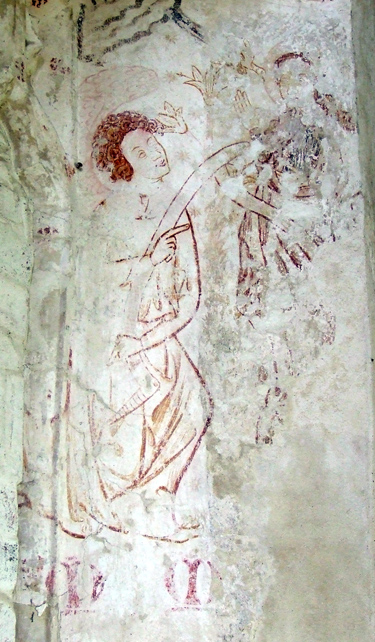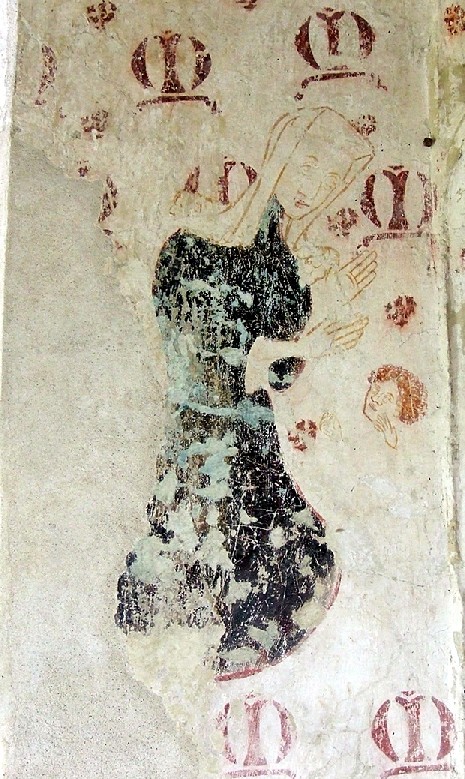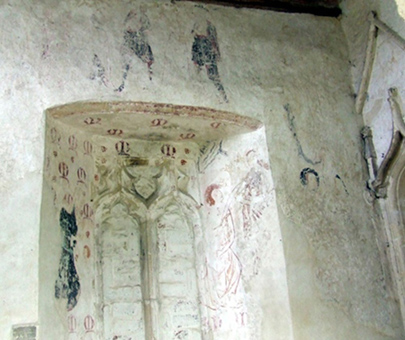Chapel of Our Lady of Bradwell, Bradwell Abbey, Buckinghamshire (†Oxford), C.14
The Annunciation and St Anne Teaching the Virgin to Read

Bradwell Abbey itself is now a ruin, but the priory church belonging to it (once a very important pilgrimage site) has some very interesting wall paintings, all of which I hope to include here in due course. The two on this page are the clearest.
Shown at the right (on the right-hand window splay on the wall) is the Annunciation. Gabriel bends one knee to salute the Virgin, who stands at the right, one hand raised. At the top left of the scene are some wavy lines intended, I think, to suggest Heaven, with another blue-grey slanting band of pigment¹ that resolves into the very faint outline of the Dove of the Holy Spirit with extended neck and head just touching the edge of the Virgin’s halo in a way very similar to that in the near-contemporary example at Ashampstead. It is difficult if not impossible to tell whether details like this suggest the Holy Spirit entering Mary through her ear, a view held by some very early Christian writers, and possibly by St Augustine himself. An auditory route for the transmission of the Holy Spirit into Mary, and thus for the Incarnation, was a matter much debated in the early Church. A speech-scroll extends from Gabriel’s left hand toward Mary, and there are at least two lilies, although it is impossible to tell which of the figures is holding them, or indeed if either is – they may simply have been painted as symbolic background detail. But there is a hint of a square lectern at the far right of the painting, so this may be another reading Virgin, as at Barnby and Gisleham in Suffolk.

At the left is a painting of St Anne teaching the Virgin. St Anne is the taller figure wearing a white headdress and inclining, with hands held open and apart, towards her daughter, a tiny child-figure at the right. The young Virgin shares the very curly hair of Gabriel in the Annunciation and she holds her small hands apart in a similar way to her mother. The attitudes of the two figures, and some very faint but regular straight lines between St Anne’s extended hands suggest that she may once have been holding an open primer or horn-book, much as her daughter does in the contemporary example at Corby Glen, and that the child-Virgin may have been reaching upwards to grasp it, possibly as evidence of her intellectual precocity.
The complete absence of haloes is very odd, and at Bradwell this cannot simply be put down to fading. There is not the slightest hint of a halo anywhere in the scene, even at huge magnification. This should give us pause, perhaps, but I cannot suggest any other subject that the scene might represent, and it seems to have been accepted as St Anne teaching the Virgin from an early date.
The insistently curly hair of both Gabriel in the Annunciation and the youthful Virgin in the St Anne scene is, if anything, odder still, given that curly or unruly hair in medieval art is normally a signifier of evil, or at least dubious, character, as in the case of the fallen idol summarily dealt with by St James at Stoke Orchard or the hair of the guilt-ridden Cain at Kelmscott. Both these paintings are earlier, though, so perhaps we are looking at changing attitudes and changing iconography in action, so to speak. But we are certainly looking at the pinnacle of Marian devotion, as the repeated “M” (for “Mary”) motifs around the paintings testify. The painting on the ceiling is later, probably 17th century.

Finally, the photograph at the right shows the blocked window in the north wall around which these two subjects are painted. The adjoining wall at the right shows part of the niche which once held the miraculous healing statue of the Virgin (gone at the Reformation) that made Bradwell Abbey a pilgrimage centre. The details above the window, showing pilgrims bringing votive offerings to the statue, and, on the opposite (south) wall, St Michael Weighing Souls, will all be here later this year. Bradwell Abbey is now looked after by the adjacent Milton Keynes City Discovery Centre and more about the history of the Abbey, along with much else about the history of the Milton Keynes area, which in common with that of the rest of England certainly did not begin in 1973, can be found by following the link to its website.² Access to the chapel can also be arranged via the website.
¹I suspect that this band, which looks crude and clumsy by comparison with the rest of the painting, may be a later addition intended to resolve any ambiguity about what was ‘entering’ Mary, and where it came from. Clive Rouse, in a journal article from the 1970s, may have something to say about this, but I am still trying to track the article down.
²For some very good photographs and schematic drawings of Bradwell Abbey and its chapel, and for much general material on Our Lady of Bradwell as a medieval pilgrimage site, Richard Marks, Image and Devotion in Late Medieval England, Sutton Publishing, 2004, p.197 & passim is by far the best modern resource.